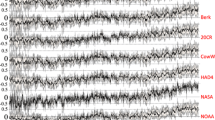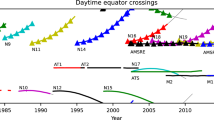Abstract
We examine to what degree we can expect to obtain accurate temperature trends for the last two decades near the surface and in the lower troposphere. We compare temperatures obtained from surface observations and radiosondes as well as satellite-based measurements from the Microwave Soundings Units (MSU), which have been adjusted for orbital decay and non-linear instrument-body effects, and reanalyses from the European Centre for Medium-Range Weather Forecasts (ERA) and the National Centre for Environmental Prediction (NCEP). In regions with abundant conventional data coverage, where the MSU has no major influence on the reanalysis, temperature anomalies obtained from microwave sounders, radiosondes and from both reanalyses agree reasonably. Where coverage is insufficient, in particular over the tropical oceans, large differences are found between the MSU and either reanalysis. These differences apparently relate to changes in the satellite data availability and to differing satellite retrieval methodologies, to which both reanalyses are quite sensitive over the oceans. For NCEP, this results from the use of raw radiances directly incorporated into the analysis, which make the reanalysis sensitive to changes in the underlying algorithms, e.g. those introduced in August 1992. For ERA, the bias-correction of the one-dimensional variational analysis may introduce an error when the satellite relative to which the correction is calculated is biased itself or when radiances change on a time scale longer than a couple of months, e.g. due to orbit decay. ERA inhomogeneities are apparent in April 1985, October/November 1986 and April 1989. These dates can be identified with the replacements of satellites. It is possible that a negative bias in the sea surface temperatures (SSTs) used in the reanalyses may have been introduced over the period of the satellite record. This could have resulted from a decrease in the number of ship measurements, a concomitant increase in the importance of satellite-derived SSTs, and a likely cold bias in the latter. Alternately, a warm bias in SSTs could have been caused by an increase in the percentage of buoy measurements (relative to deeper ship intake measurements) in the tropical Pacific. No indications for uncorrected inhomogeneities of land surface temperatures could be found. Near-surface temperatures have biases in the boundary layer in both reanalyses, presumably due to the incorrect treatment of snow cover. The increase of near-surface compared to lower tropospheric temperatures in the last two decades may be due to a combination of several factors, including high-latitude near-surface winter warming due to an enhanced NAO and upper-tropospheric cooling due to stratospheric ozone decrease.
Similar content being viewed by others
Author information
Authors and Affiliations
Additional information
Received: 5 May 1999 / Accepted: 15 December 1999
Rights and permissions
About this article
Cite this article
Stendel, M., Christy, J. & Bengtsson, L. Assessing levels of uncertainty in recent temperature time series. Climate Dynamics 16, 587–601 (2000). https://doi.org/10.1007/s003820000064
Issue Date:
DOI: https://doi.org/10.1007/s003820000064




